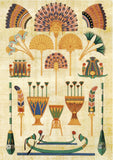
Linen, in addition to being the oldest textile fiber used, is one of the most ecological fabrics. Made in Europe, although put aside for some time, linen is certainly a textile to be rediscovered in clothing but also through many other uses.
History and linen

Linen is probably the oldest plant fiber used for making textiles. In fact, this fiber has been known since Antiquity. Research has shown that 3000 BC, linen was the main element of the Pharaonic economy and was used to wrap Egyptian mummies.
Having uses that have evolved over time, linen remains a prestigious, silky fiber produced in small quantities. In the 20th century, we were treated to a revival of linen.
Today, the use of this fiber has decreased with the arrival of cotton. Belgium, the Netherlands and France at the top of the list, alone represent around 80% of world production. 90% of European flax still finds use in textiles today and it is estimated that 10% is currently used in certain innovations such as the automobile industry, eco-construction and as a replacement for fiberglass.
The ecological aspects of linen

Linen is at the top of the list of eco-friendly textiles and leaves a small footprint on the environment. In fact, the cultivation of this plant requires neither fertilizer nor pesticides. In addition, watering is not necessary since rainwater alone is sufficient. When transforming the raw material into yarn, the process of retting (maceration to separate the fiber) and scutching (mechanical separation) is entirely mechanical and requires no chemicals. In addition, the processing of linen is very energy-efficient and due to its plant nature, it is a biodegradable fiber. However, although less polluting than other plants, its intensive cultivation impoverishes the soil.
The properties of linen

It is a textile appreciated for its flexibility and lightness. Due to the insulating and thermoregulatory property of its fiber, the fabric keeps us cool in summer and warm in winter. Being a natural fiber, linen has hypoallergenic properties and does not irritate the skin. In addition, it is a material that can absorb up to 20% moisture leaving us dry and drying quickly transferring moisture quickly to the outside. Being one of the strongest fibers, this makes it a quality and durable textile that does not lint or deform. Although wrinkled, linen becomes increasingly softer with washing.
If we compare some of its characteristics with cotton , in addition to being from a much more ecological production, linen fibers have the same fineness and are 2 or 3 times higher in terms of tensile strength. It is therefore a much more durable fabric.
And in Canada?
For the moment, although the potential exists, there is no dedicated flax culture for textiles in Canada. As in the case of hemp , it would be really interesting if facilities were set up to cultivate and process it. Currently, given our climate, these would be the only 2 possible Canadian textiles but none still exist to this day.
Linen is therefore a highly ecological textile that deserves to be integrated more into our clothing. Whether by its method of production requiring no chemicals or irrigation water, by its purely mechanical transformation and by its durability, it clearly has the advantage of being made available in our markets!
Ecologically yours,














0 comments